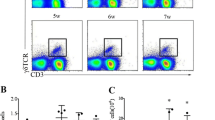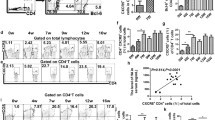Abstract
Schistosome infection could cause significant liver damage in animal; Th2 cells play an important role in the progress of this disease. In our study, C57BL/6 mice were infected by Schistosoma japonicum and lymphocytes were isolated from the liver to detect some characteristics of interleukin-5 (IL-5)-producing T cells by different methods. The results revealed that S. japonicum infection could induce a large amount of IL-5 in mouse liver T cells by the means of fluorescent bead immunoassay and RT-PCR. Although, mouse liver contained many T cell subsets, such as Th cells, Tc cells, NKT cells, and γδ T cells. Fluorescence activated cell sorting results indicated that Th cells were the main source of IL-5 in the T cell population after phorbol 12-myristate 13-acetate and ionomycin stimulation. Moreover, the percentage of IL-5-producing Th cells continued to increase from 4 to 8 weeks after S. japonicum infection, which differed from the changes of IFN-γ+ Th1 cells, IL-4+ Th2 cells, and IL-17A+ Th17 cells during S. japonicum infection. Additionally, cytokines co-expression results demonstrated that 36.2 % of IL-5+ Th cells could express IL-4, and 10 % of it could produce IFN-γ or IL-17A. Collectively, these findings implied that IL-5-producing Th cells posses some properties which differ from other cytokines secreting Th cells.





Similar content being viewed by others
References
Aarvak T, Chabaud M, Miossec P, Natvig JB (1999) IL-17 is produced by some proinflammatory Th1/Th0 cells but not by Th2 cells. J Immunol 162:1246–1251
Asahi H, Stadecker MJ (2003) Analysis of egg antigens inducing hepatic lesions in schistosome infection. Parasitol Int 52:361–367
Bloch EH, Wahab MF, Warren KS (1972) In vivo microscopic observations of the pathogenesis and pathophysiology of hepatosplenic schistosomiasis in the mouse liver. AmJTrop Med Hyg 21:546–557
Blom KG, Qazi MR, Matos JB, Nelson BD, DePierre JW, Abedi-Valugerdi M (2009) Isolation of murine intrahepatic immune cells employing a modified procedure for mechanical disruption and functional characterization of the B, T and natural killer T cells obtained. Clin Exp Immunol 155:320–329
Cheever AW, Xu YH, Sher A, Macedonia JG (1991) Analysis of egg granuloma formation in Schistosoma japonicum-infected mice treated with antibodies to interleukin-5 and gamma interferon. Infect Immun 59:4071–4074
Curry MP, Norris S, Golden-Mason L, Doherty DG, Deignan T, Collins C, Traynor O, McEntee GP, Hegarty JE, O’Farrelly C (2000) Isolation of lymphocytes from normal adult human liver suitable for phenotypic and functional characterization. J Immunol Methods 242:21–31
de Jesus AR, Magalhaes A, Miranda DG, Miranda RG, Araujo MI, de Jesus AA, Silva A, Santana LB, Pearce E, Carvalho EM (2004) Association of type 2 cytokines with hepatic fibrosis in human Schistosoma mansoni infection. Infect Immun 72:3391–3397
Dutra WO, Correa-Oliveira R, Dunne D, Cecchini LF, Fraga L, Roberts M, Soares-Silveira AM, Webster M, Yssel H, Gollob KJ (2002) Polarized Th2 like cells, in the absence of Th0 cells, are responsible for lymphocyte produced IL-4 in high IgE-producer schistosomiasis patients. BMC Immunol 3:8
Harrington LE, Hatton RD, Mangan PR, Turner H, Murphy TL, Murphy KM, Weaver CT (2005) Interleukin 17-producing CD4+ effector T cells develop via a lineage distinct from the T helper type 1 and 2 lineages. Nat Immunol 6:1123–1132
Hemida MH, Mahmoud NS, El MM, Ammar ES, Kilany YF, El TD, El DT (2010) Interleukin (IL)-12, Il-5 and total IgE in hepatosplenic schistosomiasis with or without asthma. J Egypt Soc Parasitol 40:367–376
Ikutani M, Yanagibashi T, Ogasawara M, Tsuneyama K, Yamamoto S, Hattori Y, Kouro T, Itakura A, Nagai Y, Takaki S, Takatsu K (2012) Identification of innate IL-5-producing cells and their role in lung eosinophil regulation and antitumor immunity. J Immunol 188:703–713
Jankovic D, Cheever AW, Kullberg MC, Wynn TA, Yap G, Caspar P, Lewis FA, Clynes R, Ravetch JV, Sher A (1998) CD4+ T cell-mediated granulomatous pathology in schistosomiasis is downregulated by a B cell-dependent mechanism requiring Fc receptor signaling. J Exp Med 187:619–629
Kaplan MH, Whitfield JR, Boros DL, Grusby MJ (1998) Th2 cells are required for the Schistosoma mansoni egg-induced granulomatous response. J Immunol 160:1850–1856
Lenzi HL, Romanha WS, Santos RM, Rosas A, Mota EM, Manso PP, Caputo LF, Pelajo-Machado M (2006) Four whole-istic aspects of schistosome granuloma biology: fractal arrangement, internal regulation, autopoietic component and closure. Mem Inst Oswaldo Cruz 101(Suppl 1):219–231
Li YS, Sleigh AC, Ross AG, Williams GM, Tanner M, McManus DP (2000) Epidemiology of Schistosoma japonicum in China: morbidity and strategies for control in the Dongting Lake region. Int J Parasitol 30:273–281
Milner T, Reilly L, Nausch N, Midzi N, Mduluza T, Maizels R, Mutapi F (2010) Circulating cytokine levels and antibody responses to human Schistosoma haematobium: IL-5 and IL-10 levels depend upon age and infection status. Parasite Immunol 32:710–721
Saunders M, Taubert A, Dafa’Alla T, Zahner H (2008) Effect of chemotherapeutic treatment on cytokine (IFN-gamma, IL-2, IL-4, IL-5, IL-10) gene transcription in response to specific antigens in Brugia malayi-infected Mastomys coucha. Parasitol Res 103:1163–1176
van den Biggelaar AH, Borrmann S, Kremsner P, Yazdanbakhsh M (2002) Immune responses induced by repeated treatment do not result in protective immunity to Schistosoma haematobium: interleukin (IL)-5 and IL-10 responses. J Infect Dis 186:1474–1482
Vujanovic NL, Polimeno L, Azzarone A, Francavilla A, Chambers WH, Starzl TE, Herberman RB, Whiteside TL (1995) Changes of liver-resident NK cells during liver regeneration in rats. J Immunol 154:6324–6338
Wang W, Wang L, Liang YS (2012) Susceptibility or resistance of praziquantel in human schistosomiasis: a review. Parasitol Res 111:1871–1877
Weaver CT, Hatton RD, Mangan PR, Harrington LE (2007) IL-17 family cytokines and the expanding diversity of effector T cell lineages. Annu Rev Immunol 25:821–852
Wilson MS, Mentink-Kane MM, Pesce JT, Ramalingam TR, Thompson R, Wynn TA (2007) Immunopathology of schistosomiasis. Immunol Cell Biol 85:148–154
Yamaguchi Y, Hayashi Y, Sugama Y, Miura Y, Kasahara T, Kitamura S, Torisu M, Mita S, Tominaga A, Takatsu K (1988) Highly purified murine interleukin 5 (IL-5) stimulates eosinophil function and prolongs in vitro survival. IL-5 as an eosinophil chemotactic factor. J Exp Med 167:1737–1742
Yssel H, Bensussan A (2010) Is there a novel subset of Th22 lymphocytes in the skin distinct from Th17 lymphocytes? Med Sci (Paris) 26:12–14
Zhang CW, Xiao SH (2012) Histopathological changes of juvenile Schistosoma japonicum harbored in mice treated orally with mefloquine at a smaller single dose. Parasitol Res 110:2281–2288
Zhang Y, Chen L, Gao W, Hou X, Gu Y, Gui L, Huang D, Liu M, Ren C, Wang S, Shen J (2012) IL-17 neutralization significantly ameliorates hepatic granulomatous inflammation and liver damage in Schistosoma japonicum infected mice. Eur J Immunol 42:1523–1535
Zhu Y, Lukacs NW, Boros DL (1994) Cloning of TH0- and TH2-type helper lymphocytes from liver granulomas of Schistosoma mansoni-infected mice. Infect Immun 62:994–999
Acknowledgments
This work was supported by a grant from the Natural Science Foundation of China (30901353) and Natural Science Foundation of Hunan Province, China (11JJ3103) and Science and Technology Planning Project of Guangzhou City (2011 J22007). We thank Prof. Hu Xuchu in the Department of Parasitology at Zhongshan School of Medicine, Sun Yat-sen University who provide help in animal infection.
Conflict of interest
The authors declare no conflict of interest with this work.
Author information
Authors and Affiliations
Corresponding authors
Additional information
Hongyan Xie and Dianhui Chen equally contributed to this work.
Rights and permissions
About this article
Cite this article
Xie, H., Chen, D., Luo, X. et al. Some characteristics of IL-5-producing T cells in mouse liver induced by Schistosoma japonicum infection. Parasitol Res 112, 1945–1951 (2013). https://doi.org/10.1007/s00436-013-3350-2
Received:
Accepted:
Published:
Issue Date:
DOI: https://doi.org/10.1007/s00436-013-3350-2




